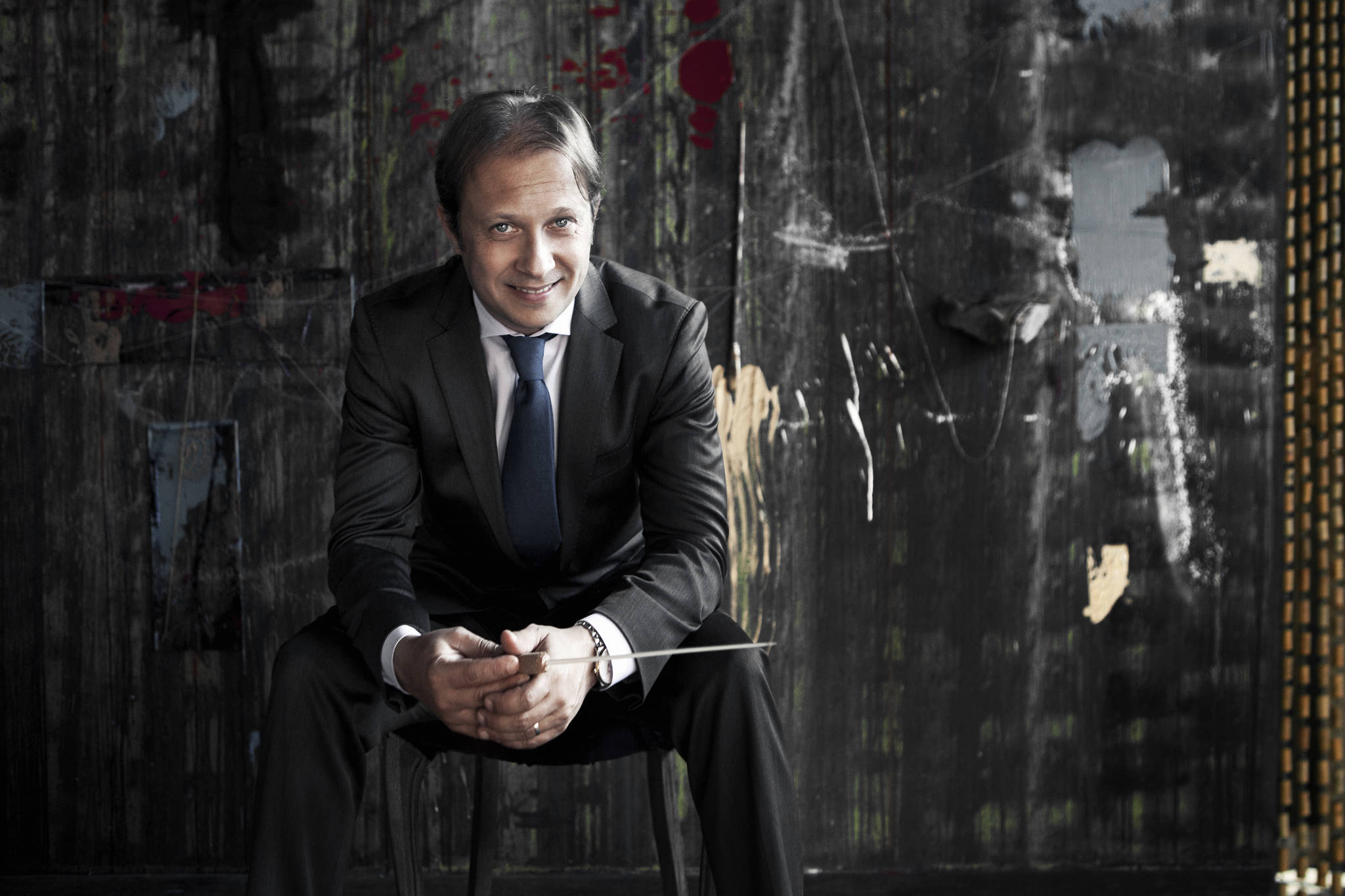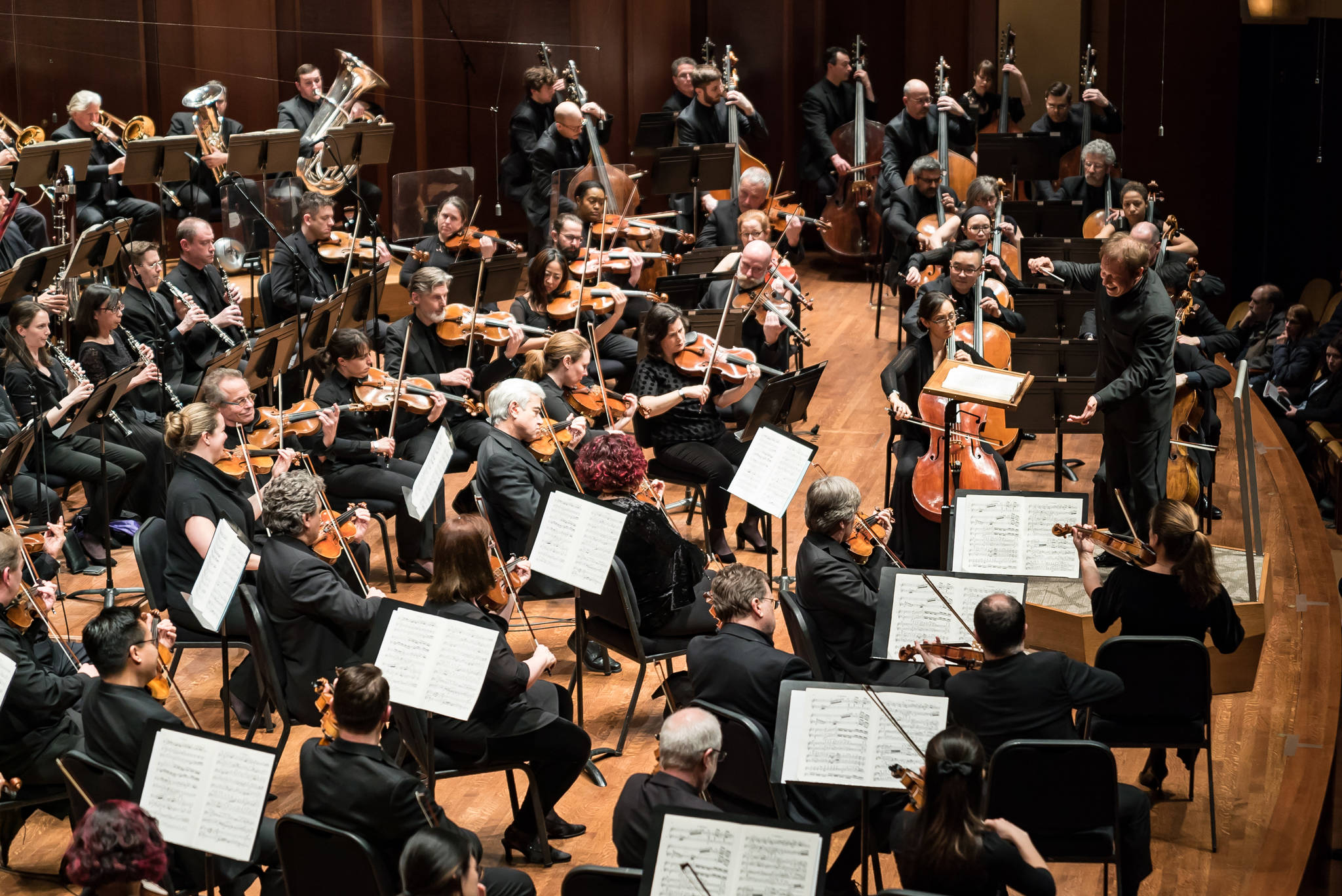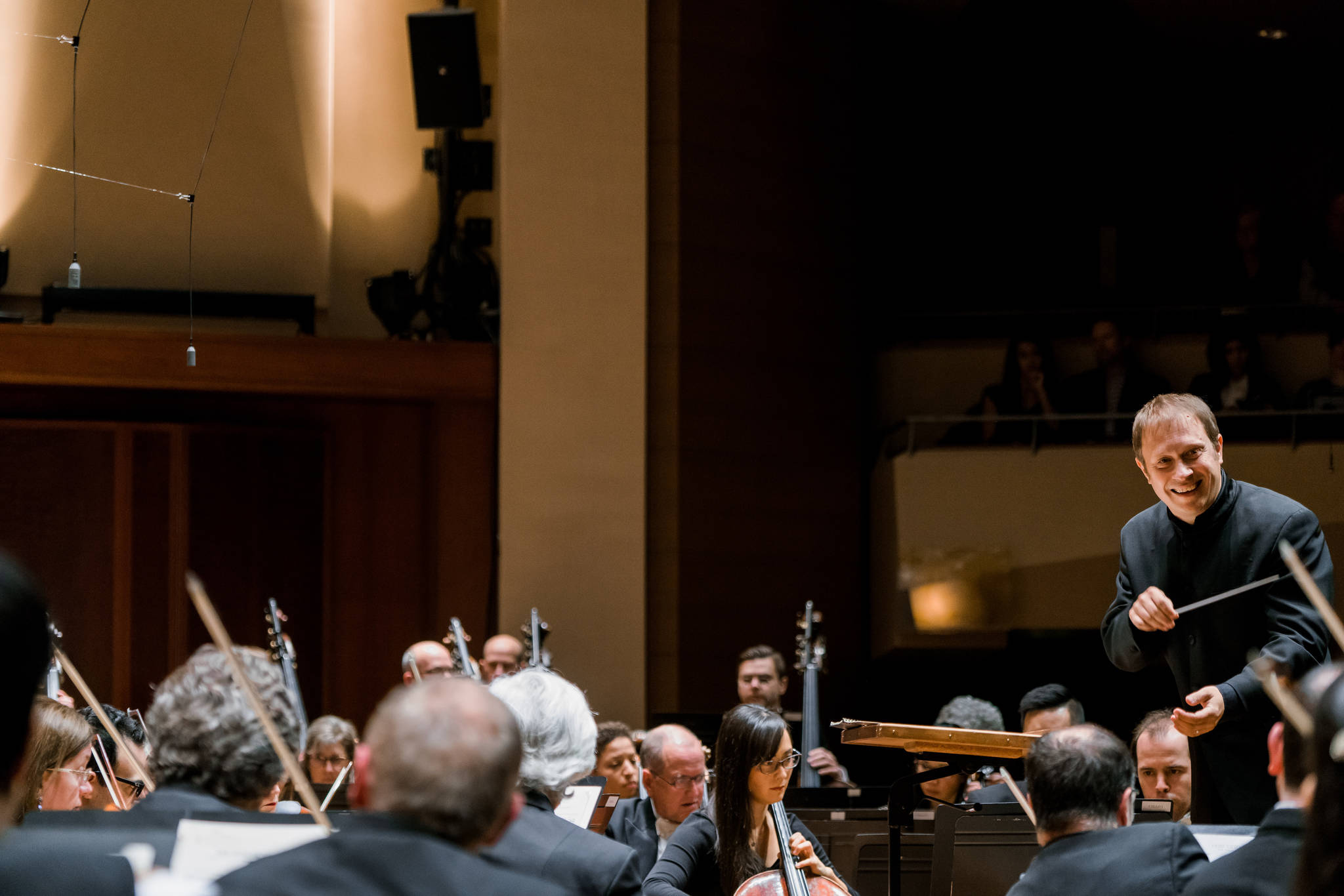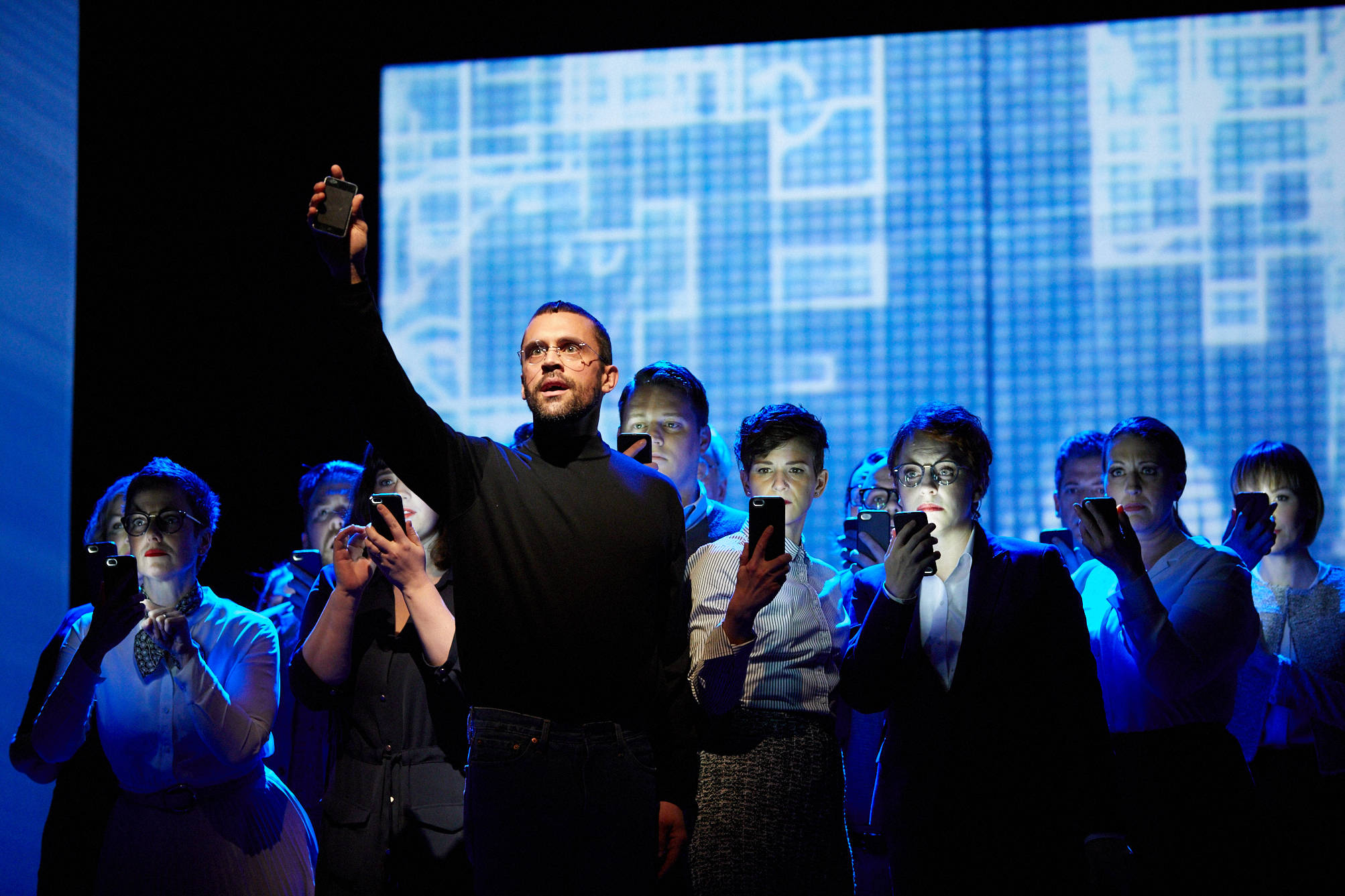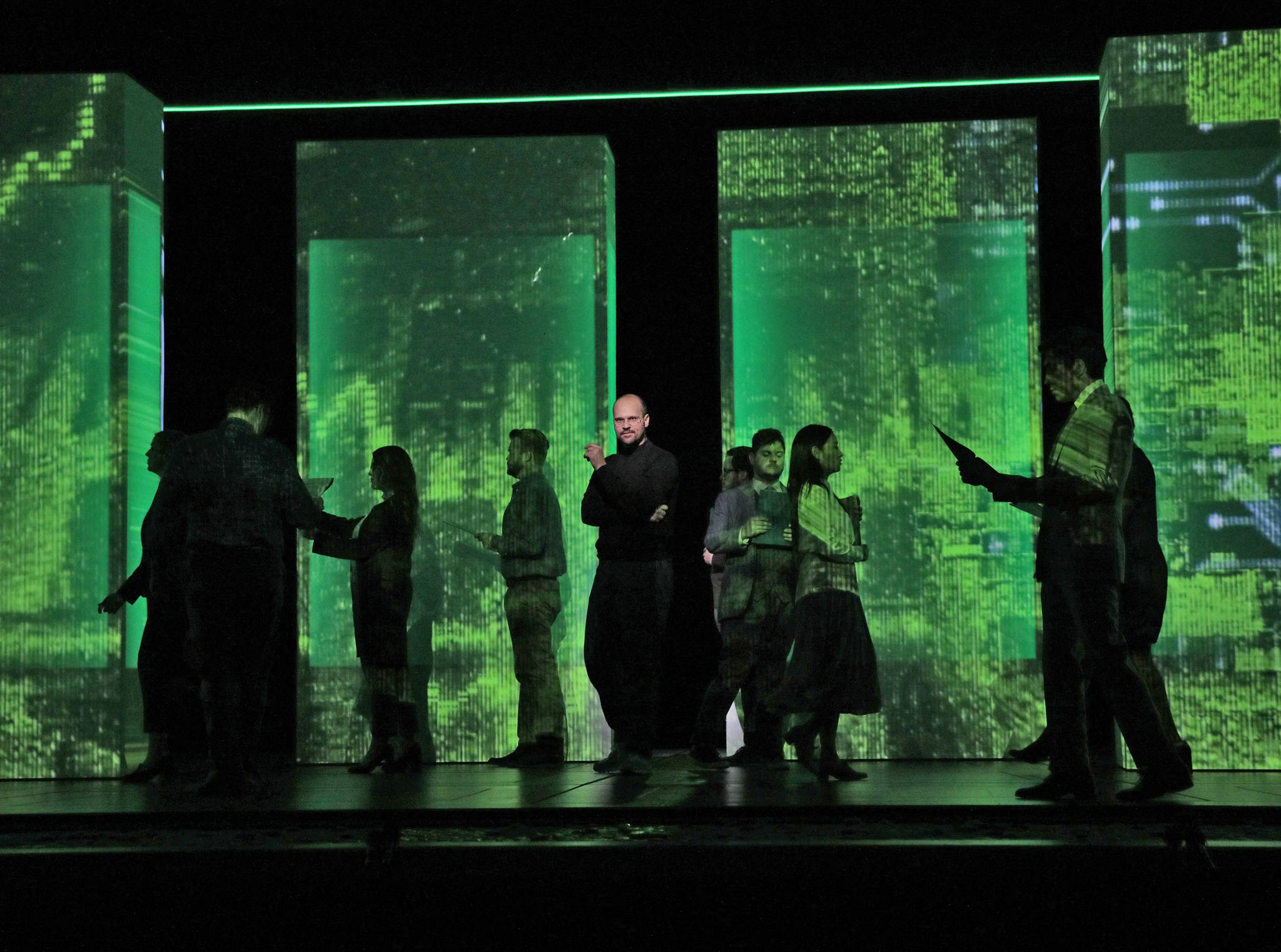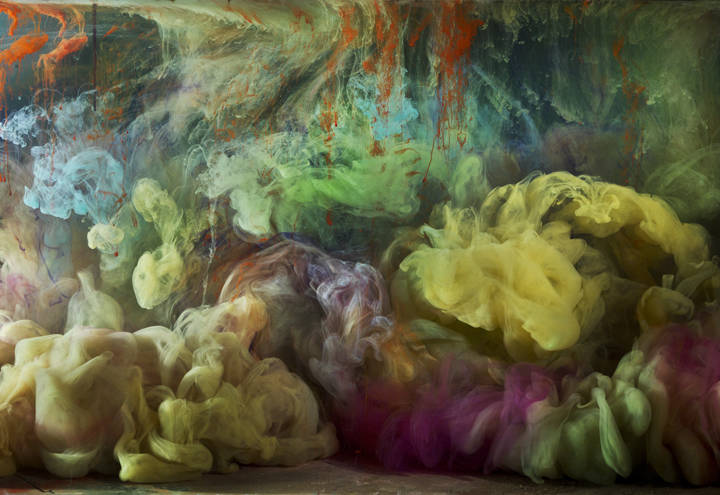“Leave ’em wanting more” runs the old showbiz adage, and Seattle Symphony music director Ludovic Morlot had it in mind when on April 21, 2017, the orchestra announced his eighth season in the post would be his last. Seems like just yesterday the Symphony took a chance on a guy who’d guest-conducted here only twice when the instiution named him the surprise successor to Gerard Schwarz’s Ken Jennings-esque 26-year tenure in June 2010. And now here we are. With his final season now launched, I met Morlot last week for a sort of premature exit interview, asking him—after a cup of espresso and some Champions League chatter about his beloved Olympique Lyonnais—about the coming season and the preceding seven.
So you’re looking down the homestretch now.
I’m not sure I realize [it] so much now as I did when I was debating about making that decision, because the timing is always weird—you decide those things way before it happens, so it’s really always a tough act to make those decisions at the right moment. So it felt for me more of a struggle at that time than it is now. Now it’s just about enjoying that incredible legacy that we’ve built, and pushing it as far as we can. With a different energy, I have to admit, because the fact that you know you’re only going to have those few weeks makes everybody actually a little bit more relaxed onstage. And the best music often happens when everybody is in that place. It can be actually a very satisfying environment that is being created by that energy of celebrating, really, the music we’ve accomplished.
What led to this decision? Does it have anything to do with your future plans?
No, not quite—well, everything is connected, you know. The big decision came from realizing that I would be turning 45. A lot of people consider that being their middle period when it comes to creativity. And I felt that in those eight years at the helm of the Seattle Symphony—which was my first position as a music director, combined with the one in Brussels, but starting at almost the same time. But it felt to me that eight years was a big slice of my creative life, and that I wanted to—not only for myself but also for the orchestra—to allow the future to hold a more intense, challenging environment for all of us. It’s all about trying to put the best conditions to be able to grow bigger and earlier and faster as an artist.
And I thought there would be that danger maybe of not only starting to repeat some of the things we’ve done—which can be also valid, because you add layers coming back to some of the repertoire. But I’m not talking so much of repertoire as ideas for the organization. I felt like I had thrown all my eggs in that basket, and that it was time for the basket to grow to something bigger or different in order to accomplish an outstanding journey over the next three, four, five leaders of this organization artistically. So I was really trying to avoid that danger of becoming too comfortable. Because this is our enemy, right? We have two enemies when it comes to making music: time—never having enough time—and then the danger of feeling too comfortable. And that’s never healthy for anybody. Not that I felt that when I made that decision, but I could see that at some point it would be coming.
Since you used the word “legacy”: If 20 years from now people talk about “The Morlot Era” at the Seattle Symphony, what do you think they will think of? What would you like them to think of?
I would like to think that we’ve been able to put this orchestra in a more international light. This is important for me because it relates to music-making, it relates to a civic pride, a pride of belonging to an organization that is being recognized and viewed from the international perspective—as we know with the [recently won] Orchestra of the Year [award from British music magazine Gramophone]. I was looking at every year for the last four years—we’ve had really, really successful recognition from outside of Seattle: the Grammys, the Gramophone. I think this is an important asset of what I would like to be my legacy, because I think this will help the orchestra to tour, to go even bigger in ambition, and therefore attracting more outstanding musicians here and be even more daring with projects.
What I hope was to have really excited the community and really grow the audience. You know we have grown the audience in the last few years tremendously. This is very important again when it comes to that improvement of the music-making, because we play better when the hall is full; we play better when we know that people are listening with more attention and more knowledge and more care, more curiosity. So this is a big accomplishment. There are very specific things, like growing the size of the orchestra in an era where everywhere else, everything’s shrinking—that has been something very important to me because again I wanted to create more comfort onstage when it comes to allowing the players to deliver the best of themselves when they are actually under the spotlight.
Seattle Symphony Media is a huge legacy—and through the Grammys and the Gramophone, we know that has already been recognized. This has been an important step because it gave us freedom in programming for recordings, therefore it gave us a better opportunity to establish an identity as an orchestra. I hope this orchestra feels that they are as versatile as before, but with even a bigger palette of repertoire; that the sound has become more not only cohesive, but more flexible. One of the players was saying how they feel that they can really embrace all the different genres of music that are put in front of them. I think this was already so true when I took on this role, but I think we’ve expanded that tremendously. The sound world of this orchestra has changed. And one thing I would also like to credit to the work we’ve done together: I find the orchestra is playing like a chamber-music ensemble, meaning that the level of listening onstage has improved tremendously. And I like to think it’s part of my legacy and the detailed work we’ve been doing.
I was going to ask just that: How is the orchestra different from when you got here? You talked about the way they play—how about the organization as a whole?
There have been a lot of changes, of course, with personnel, so that means incredible changes in perspective. But I think everyone can agree that everybody’s been fighting for a very ambitious vision. And that’s my job—I always felt like I was maybe a step ahead of what the organization really was ready to embrace in terms of workload. But I think by pushing the envelope constantly, everybody has always showed so much support to the vision, that I think this organization has grown now tremendously in not only embracing the vision but being a step ahead of it. So I think the reverse has happened: I hear so many new and fresh ideas coming to me from bouncing back from what my vision originally was, that I feel that onstage now it’s much more like teamwork, where we all communicate, dialogue, exchange, disagree, move forward by stepping one step back and jumping further. So all this dynamic is happening throughout the organization, which I find it thrilling because it comes from new people coming in—but it also comes from that pride that I was talking about: When you work hard and you feel the reward for it, it’s not work anymore. And I think that has become really the energy that I sense we’re evolving into.
Can you talk about anything you would have liked to have done that you didn’t get a chance to? Any loose ends?
One thing, very simple—and I think the ideas were there, but maybe on that chapter I was maybe two steps ahead of the organization—is touring. You know, my dream was to take this orchestra around the world. And this will happen, I’m very confident; it was a little premature when we started planning it. But my big regret—if I can use such a big word—but one of the things I haven’t been able to accomplish for the musicians is to take them on the road more often, and to communities that are very different. I wanted to go to Asia, I wanted to go to Europe. I hope this is something that will materialize in the next era for this orchestra.
I can imagine it must be something that incoming music director Thomas Dausgaard is interested in.
Oh, I can only imagine… and he does it a lot with his BBC [Scottish Symphony] Orchestra and the Swedish Chamber Orchestra. So I think it will be in his DNA for sure. And it has been something we’ve had many conversations with in the organization too because once an orchestra hasn’t been in the habit of touring, you have to also establish what are the artistic values of such an activity. So I’ve been very, very vocal about the fact that it is possibly one of the best instruments for artistic growth. Because by repeating 10 or even five times the same repertoire, in different halls and different environments—with always this adrenaline that you get on tour because you know you’re gonna be playing that one night in that place, and you have to be the best possible ambassador of the work you’ve done—this gets the orchestra instantly to another level, because then you come back home and you feel you really own that repertoire. And that’s maybe the one thing I would have like to have achieved during my tenure.
Well, I remember vividly the New York Carnegie Hall appearance, which was a success in every imaginable way.
And I think not only the orchestra is ready for it artistically, but I think that as an organization we’re getting there too. Not getting there—we are there.
What are you particularly excited about in the coming season—the concerts I absolutely shouldn’t miss?
We kick off the big focus that we are gonna have on Debussy’s music this year, put in perspective with music of Janáček. That theme of Debussy throughout the season is something I would invite people to pay attention to. Even some lesser-known pieces—like next week we’re playing Printemps by Debussy, which is a very early piece that is not heard very often (Sept. 27–29), but we play it alongside Daphnis and Chloe of Ravel, a wonderful pairing. With also a new focus on [the music of Marc-Andre] Dalbavie, which for me is the continuation of the work we did on [Henri] Dutilleux, with the French sound.
A little unusual for me is to tackle the music of Shostakovich. I don’t do much of his music—
Schwarz did a lot.
He did more of the war symphonies, and so I decided to do the first and last. I’ve always had a very, very special feeling for the 15th symphony (March 21 & 23), but also because the first one is a piece written by a 20-year-old Shostakovich, which I find delightful and wonderful (Jan. 31–Feb. 2). So this in combination with a bit more Bartók as well—talking about things I would have liked to bring a little bit more of. So we’re doing [Shostakovich’s] second violin concerto with Alina Ibragimova (Nov. 1–3). I look forward to this very much also because it’s not played very often.
And then the big, big, big, projects for me are the B Minor Mass, Bach (March 14, 16–17). It’s fitted to be in my last season, because it’s the work that Bach wrote late in his life as kind of a compilation of all his better ideas. So it comes as a very nice time in the spring where it feels that we can really embrace this piece almost as a farewell concert. Of course the [Heiner] Goebbels’ Surrogate Cities is something I look forward to tremendously as well, because it’s so much in line with the bold programming visions that we’ve had all along in presenting very daring new pieces alongside the canon repertoire. This will be particularly exciting because not only are we presenting that project, but he is actually writing an extra movement just for Seattle. It’s about the impact of urbanism on society, and to have that extra few minutes of music specifically written for that occasion will make it even more special (April 25 & 27).
A long time in the being is this commission from John Harbison, with whom I always had a very, very strong connection from my days in Boston. I asked him many years ago to write a piece for organ and symphony, because I wanted to display that organ a little bit more often, and finally it’s there. So it took a little while, but it comes this year (March 21 & 23).
Some recording projects are still exciting—we are going to continue our association with John Luther Adams, with Become Desert and Become River as a triptych with his Become Ocean. We will do a CD with Dalbavie—a lot of concertos that haven’t been recorded yet—and what excites me about the project is that it features our musicians as soloist: Mary Lynch as oboist, Demarre McGill as flutist [in concert April 18 & 20]. This is also one of the things I’m most proud of: being able to bring those wonderful musicians here, and that’s my way of giving that back a little bit.
I know his name, but I don’t know that I’ve heard anything by Dalbavie; how old is he?
50s. He’s written beautiful stuff, he’s writing more and more opera now, for Salzburg. Big voice. Big, important voice.
Was he a student of Dutilleux?
No, he was more a student of [Pierre] Boulez at first, but his music has grown into something much more romantic.
Well, everyone’s more romantic than Boulez…
Well, I don’t know—actually as I listen to his music now, I find it actually very, very romantic. [Laughs] It just takes a good performance to really enjoy that music. We are doing, actually, Sur incises by Boulez in one of our “untitled” series [March 22], and that’s a highlight for me because I think it’s his masterpiece. It’s for three pianos, three marimbas, and three harps, and that will be thrilling in the lobby.
And of course the last two weeks will be very special, because I thought of those last two weeks in June as one big program. So that opens (June 13–15) with Wagner’s Lohengrin Act 3 prelude; goes into Strauss’ Oboe Concerto; then Jeux, Debussy, which is his last orchestral piece; then [Strauss’] Till Eulenspiegel; then continues into the following week with Wagner’s Tristan und Isolde prelude; going into Debussy’s big suite from Pelléas et Mélisande; then the “Liebestod” from Wagner; then Debussy, Nocturnes, and Janáček, The Eternal Gospel (June 20–23). For me it feels like “What would you program if you could do one stretch of four hours of music?” that all kind of collide together. So if [anyone] comes to the penultimate week, they must come to the last one too, because it will feel like a big, big connected program.
What do I forget? There’s a big recording protect coming out with Ian Bostridge, one of the leading British tenors, with more focus on the music of Berlioz—the Nuits d’été, and also Shéhérazade, Ravel, which will be interesting sung by a tenor. It was his idea and I embraced it immediately because we work together quite a bit … And there also is Debussy orchestrated by John Adams on that album—Le livre de Baudelaire. Beautiful poems…
Joël Durand, a composer from UW, is writing a commission for us, on Debussy’s Preludes (April 18 & 20). With the focus on the Debussy year, I wanted to see what he can do with being inspired by those piano preludes but making his own stamp and vocabulary with those. I just received three of the four of them already, and it’s gonna be phenomenal. Beautiful writing. Lots of women composers this year, which I’m really excited about. We never have done enough, so we’ll keep pushing it: [Kaija] Saariaho, [Sofia] Gubaidulina. Caroline Shaw is writing a piano concerto for us (Jan. 31–Feb. 2). More women on the podium, too: Ruth Reinhardt is back (Oct. 18 & 20). So it will be fun.
What’s next for you, then?
Lots of music. It’s about as much as I can tell you so far, because I’ve been actually dreaming to that moment where I can really have a bit more time for myself, because you only grow when you have time.
Time to study? or play the violin, or…?
No, time to study. Time to also continue and reconnect with organizations and orchestras and musicians that I’ve been wanting to work with, all along those years but that my schedule didn’t allow me to do. The only thing I can tell you is that I think there’ll be a little more time in Europe. Having more time will mean having a bit more opportunities for me to spend longer stretches of time there. There will be great opportunities for me maybe to be able to do more opera, because finally I’ll be able to open up slightly wider windows in my schedule. And that’s something very important to me—always has been. Something I’ve sometimes had to put a pause on, because obviously you need to be there for five-six weeks, which I cannot really leave my job here for that long.
I’m thinking a lot about many, many things, and among those things is, you know—where is orchestra music heading to? I think it’s important as I explore what my next partner in crime will be to redefine, maybe, what I want my vision to be. It’s better to kind of look at it this way rather than the other way around. I think I need to decide what I want to accomplish before I can choose the partner, right? And I think it is where I’m at, spending a lot of time on “What is an orchestra today?” We know it’s not enough to just say “We want to be relevant to our community, we want to be more connected to community projects.” This is all very good, but what does that mean looking 30 years down the road? Because I hope I can be waving my arms that long. And maybe that means that there’s a bigger role that the music director—the artistic leader, the chief conductor, whatever you call it—can have in creating a vision that is exciting beyond what we already know.
I’m thinking big models like Ivan Fischer in Budapest, for instance, who created that wonderful orchestra [the innovative Budapest Festival Orchestra] way back, and who’s been always kind of on the very, very edge of what the next big vision might be for an ensemble. And I don’t know what that means yet, but this is what I’m playing with at the moment. And I find it thrilling, because the time I’ve spent here, the time I spent leading an opera house in Europe, the time I spent traveling all around the world gives me, I hope, that energy and vision that I can focus on what could be some really exciting ideas.
Do you plan to come back and guest-conduct here?
Oh, yeah, I’m sure. Well, I’m sure of nothing, but I will make plans. This is a wonderful collaboration, and onstage is so special that I’m sure we will want to continue this work and add layers to it. You don’t need 12 weeks once you have that kind of intimacy in the music-making; in a few minutes you can add layers to what you’re working on, and I look forward to this tremendously. And I’ll be very curious about the steps that this organization takes, and I know they are in good hands, and I hope I can integrate some of those initiatives into my thinking as how to move forward.
Anything else?
Well, I want to thank everybody because I’ve been so privileged to be put in this situation where I can dream so big. This has been a thrilling journey—this is not an end to it. I think it’s like when you are a champion in any category, I think it’s best to leave at the peak of your game than waiting for people to be desperate for you to leave. [Laughs] Timing is very, very important, and I wanted to leave on a crescendo note. And this is happening beautifully with the Gramophone, and this exciting new trio of leaders—between a new CEO [Krishna Thiagarajan] and new board chair [René Ancinas] and new music director, I think there’s a tremendous opportunity for this organization to be blossoming even faster—and a community I think that is even more appreciative of what the role of the symphony in this city is. And more and more understanding, also, that a great city needs a great and healthy heartbeat—and everybody is supporting that more intensely. That’s something that I feel that we’ve accomplished all together as well.
Seattle Symphony
seattlesymphony.org
